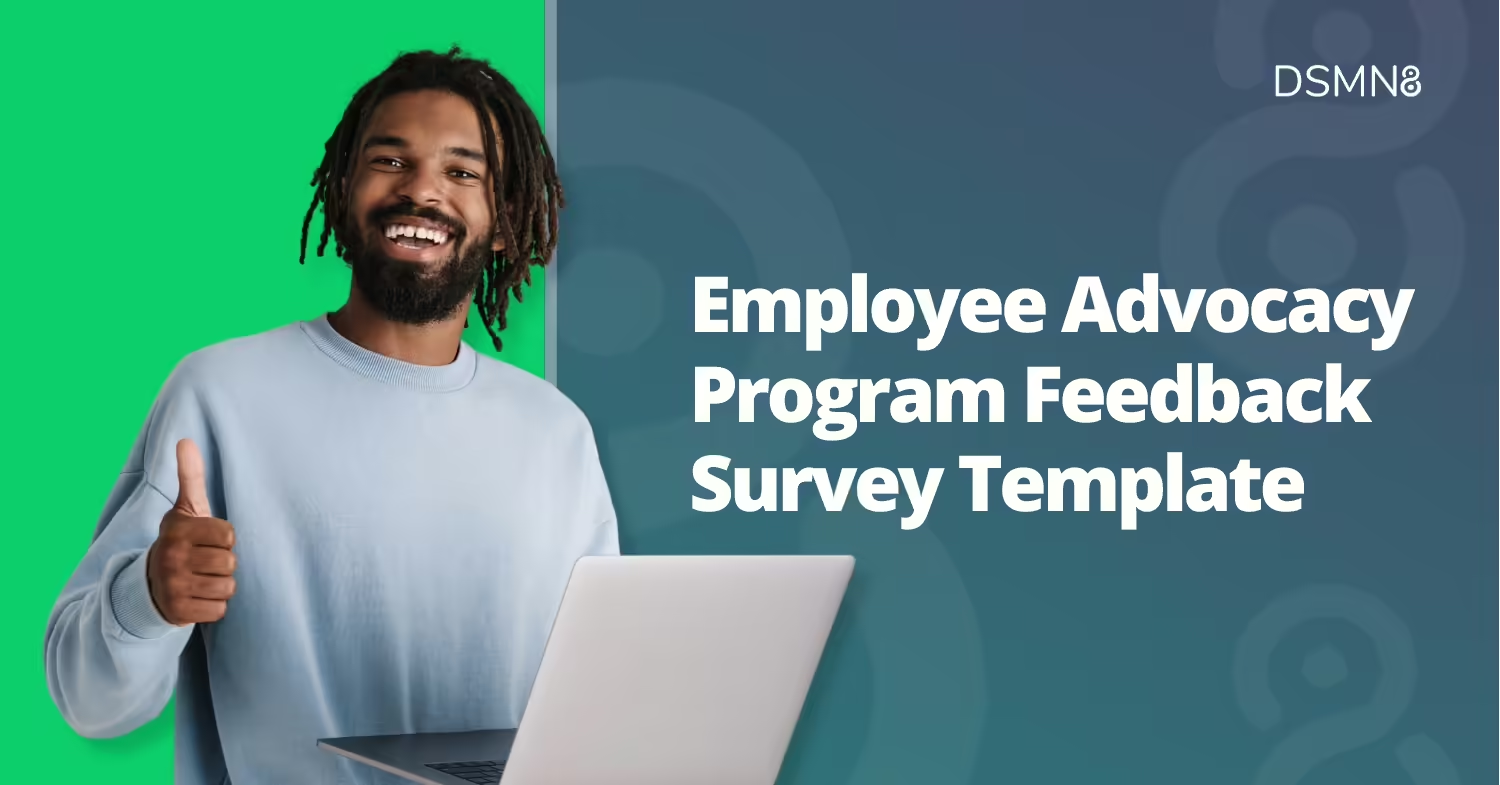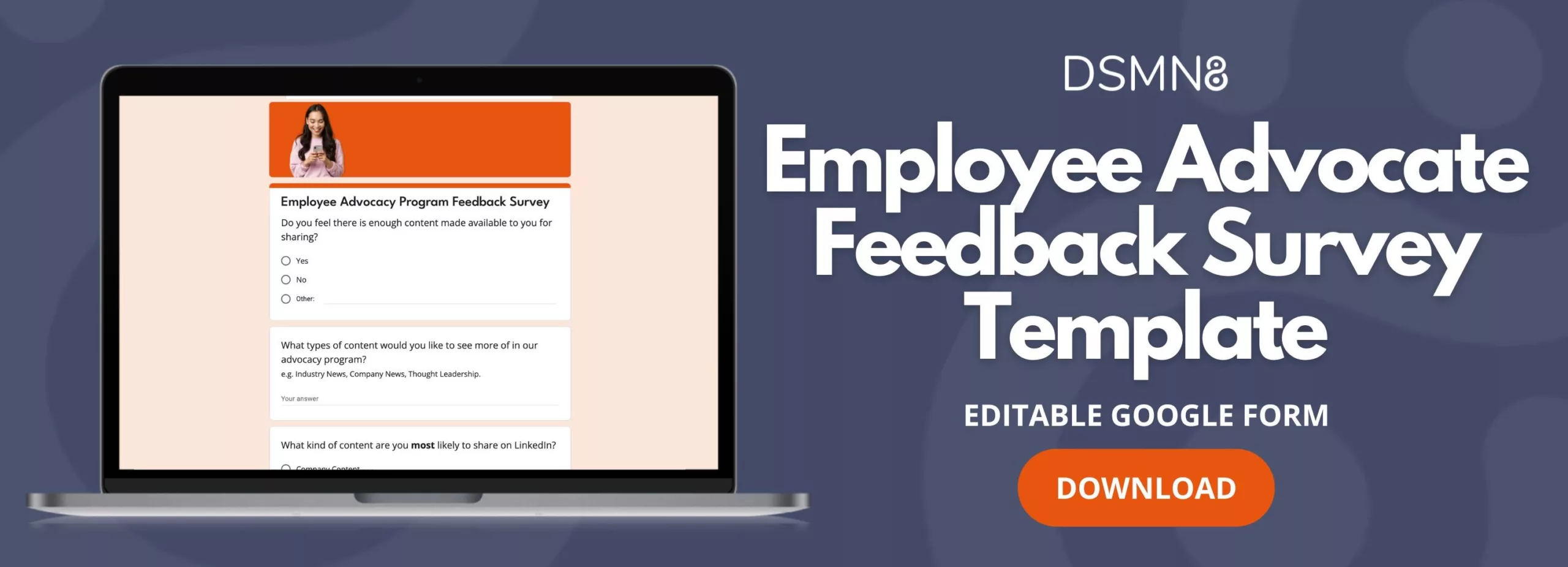
One of the most important factors of running an employee advocacy program, but one that is often neglected, is getting feedback from your advocates.
Receiving regular insights from your team enables you to create the best possible content and makes them feel valued. These insights will improve your advocacy program results and increase employee engagement.
As a content marketer, feedback and suggestions from my colleagues can be incredibly valuable. So, I spoke with our Customer Success team to find out which questions the top advocacy program managers are asking their advocates 👏
Whether you’re just getting started with advocacy or your program needs a reboot, sending out this employee feedback survey will set you on the right path.
We’ve turned this into a Google form template so you can easily share it with your team.
Why Getting Feedback from Employee Advocates is Essential
Put yourself in the shoes of your advocates.
They work in different departments and regions at varying levels of seniority.
Your CEO will likely want tailored content to share, covering company news, press features, and thought leadership.
Now, let’s consider a mid-level engineer.
They will want to share more specific content about your product or service alongside relevant industry research.
So, if your advocacy program only features marketing content, you’ll disappoint advocates who are not in marketing or sales roles.
While there will be an initial buzz from this new initiative, interest will die down if advocates can’t find content that is relevant to them.
How can I find out what content each employee wants to share?
Get regular feedback from your advocates.
This isn’t a ‘one-and-done’ task. The key to a successful employee advocacy program is to carry out this process regularly—every six months is ideal!
14 Questions To Ask Employee Advocates
1. Do you enjoy being part of the program?
Answers: Yes, No, Other (Specify).
If you’re using an employee advocacy platform, ask employees if they like the platform too, giving the option to explain why or why not.
2. Do you feel there is enough content made available to you?
Answers: Yes, No, Other (Specify).
3. What types of content would you like to see more of in our advocacy program?
Give advocates space to suggest content types for your program.
4. What types of content are you most likely to share on LinkedIn?
Answers: Company content, third-party industry news, company culture content, job openings, other (specify).
The responses to this question will help you understand which content types your advocates are most willing to share.
5. How frequently do you check if there is new content to share?
Answers: Daily, twice a week, weekly, fortnightly, monthly, other (specify).
6. Do you find the content we've been sharing relevant to your interests and role?
Answers: Yes, No. Give the option for advocates to elaborate.
7. Are there any industry trends or news topics you'd like us to cover in our content?
Answers: Open answer for advocates to suggest content ideas.
8. How can we make it easier for you to share content from the advocacy program to your social media profiles?
Answers: Open answer for advocates to suggest how sharing content can be made easier for them.
9. What motivates you to share content as part of the program, and how can we further incentivize participation?
Answers: Open answer to find out what motivates advocates, and if they have incentive ideas.
10. Are there any specific topics or themes you believe are underrepresented in the program content?
Answers: Open answer to find out any topics/themes you might be missing.
11. Have you seen an increase in engagement or interactions on your social media posts since joining the program?
Answers: Yes, No, Not Sure.
Answers: Yes, No, Not Sure.
12. What do you feel is the biggest benefit or 'win' you have experienced since joining the program?
Answers: Open answer to discover any wins your advocates have seen from being more active on social media.
13. Do you find sharing content on social media valuable to your role?
14. Would you recommend our employee advocacy program to your colleagues?
Answers: Yes, No, Maybe.
Get The Template
To use the survey template, head over to the Google Form.
Click on the three dots at the top right-hand corner, then click ‘Make a copy’.
Making a copy of the template is very important; otherwise, you won’t receive your survey responses!
How to Use Advocate Feedback To Improve Your Program
Once you’ve prepared your employee feedback survey and gathered your responses, you should use them to inform your content plan.
Keep in mind that employees know their audiences/networks.
Even though they aren’t necessarily social media experts, their content suggestions will provide valuable insight for your marketing team.
Besides, incorporating their ideas will ensure your program content is authentic and informative rather than solely brand-focused.
Implementing suggestions from your advocates will show them that you care about their input. This will help you position your advocacy program as part of your company culture, not just another ‘task’ for employees. Making employee voices heard will also help increase user adoption when you’re ready to expand your program.
Discovering the benefits or wins that your advocates have seen since joining your program is especially important. When onboarding new participants, success stories will always be more convincing than statistics. Plus, showcasing your advocates’ results will help maintain leadership buy-in and generate more internal awareness.
Another way to use employee feedback is to gauge your team’s experience with content creation and networking online. Knowing their experience level will help you plan any necessary social media training.
Additional Resources
For further guidance on advocacy program feedback, check out the podcast episode. CEO Bradley Keenan discusses why creating an advocacy feedback loop is essential and how to incorporate it into your advocacy program.
Another great resource to help with this is Bradley’s book, Employee Advocacy: 101 Cheat Codes.
It covers over 100 actionable tips for launching, managing, and scaling your employee advocacy program.
We have a limited number of free physical copies of the book, so register your interest if you’d like one!
New To Employee Advocacy?
We’ve created many more resources and templates to help you get your employees active on social media as brand ambassadors.
Whether new to employee advocacy or managing an established program, you’ll find something helpful in our Resource Hub and Templates Gallery.
Ready to get started with the #1 employee advocacy platform?
Wondering how active your team already is, and how this compares with your competitors?
Emily Neal
SEO and Content Specialist at DSMN8. Emily has 10 years experience blogging, and is a pro at Pinterest Marketing, reaching 1 million monthly views. She’s all about empowering employees to grow their personal brands and become influencers.



